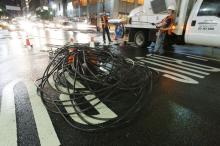Empire State Climbs Toward Expanded Connectivity
From New York City to Newfield in Upstate New York, local officials in the Empire State have kicked off projects to connect the unconnected to high-speed Internet service.
The biggest of those projects is underway in New York City as Mayor Bill de Blasio recently delivered an early Christmas present for city dwellers who want to see a term-limit set on the digital divide in the Big Apple.
America’s most populous metropolis (est. pop. 8.6 million) is investing $157 million to build publicly owned, open access broadband infrastructure that will lay the groundwork local officials say will enable high-speed wireless Internet access for up to 1.6 million city residents over the next 36 months.
Even as the city is on track to bring free or low-cost Internet service to 40,000 residents living in 18 New York City Housing Authority (NYCHA) developments by the end of the year, this latest initiative aims to expand the city’s existing fiber infrastructure while drawing on minority and women-owned Internet Service Providers to help deliver “fast, reliable, and affordable connectivity options to an additional 70,000 NYCHA residents and 150,000 residents in the surrounding communities by early 2022,” the Mayor’s Office explained in a press release announcing the initiative.
“Broadband isn’t a luxury, it’s a necessity,” de Blasio said. “We are closing the digital divide and bringing our city into the 21st century by reaching communities most in need.”
New York City Chief Technology Officer John Paul Farmer characterized the effort as evidence that city officials are “transforming the broadband marketplace.”
No matter your zip code, every New Yorker deserves an equal opportunity to participate in building our shared future. The New York City Internet Master Plan has enabled the Big Apple’s unprecedented progress in promoting digital equity and making that idealistic vision a practical reality. New York City’s bold new approach delivers cross-sector partnerships, incorporates cutting-edge technologies, upgrades performance, and ensures affordability for residents and businesses.
Mobilizing ‘NYC Internet Master Plan’




